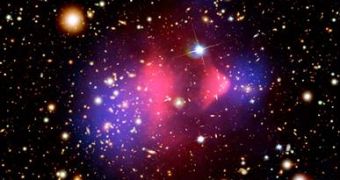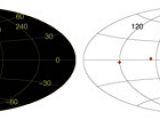ESA's gamma-ray space observatory, Integral, detected what seems to be a mysterious cloud of antimatter in the close vicinity of the Milky Way's central core, and its specific shape seems to point towards its origins, as previously there were no valid theories regarding the processes which could be held responsible for the creation of such large antimatter structures.
Antimatter represents matter formed of antiparticles. An antiparticle represents the opposite of an elementary particle, which forms all the matter consisted in the objects we experience daily. They have the same mass as their respective particles, but opposite electric charge. The interactions between a particle and an antiparticle usually result in the destructions of both and in the release of pure energy in the process, called annihilation.
Most of the previous theories regarding the origin of these particles include scenarios such as that of the decay of dark matter, but the specific radiation bursts given off by the newly discovered antimatter cloud seem to reject such theories. It seems that the gamma ray radiation emitted in the process of particle-antiparticle annihilation closely mimics the levels of energy released during electron-positron interactions.
Annihilation processes always release the same amount of energy, related to the particles that take part in the decay. For example, the electron-positron decay will always release an amount of 511 kiloelectron-volts of energy. This distinctive signature can be observed in the gamma ray emissions detected in the central core of the galaxy, ever since their first discovery nearly four decades ago.
Aside exotic particle decay which may produce antimatter, some astrophysicist proposed that massive amounts of antimatter could be released in supernovae, through the decay of newly fused heavy radioactive elements, too unstable to exist freely, but there are doubts that supernovae can be held responsible for the large mass of antimatter.
The new observations made with the help of Integral show that the cloud of antimatter visible in the center of the galactic core is not perfectly spherical; furthermore, the population of binary stars in the regions of the core seems to accurately follow the shape of the cloud, so the most probable explanation regarding the origin of the antimatter mass is that it originates in the binary systems that emit high levels of high-energy X-ray light.
Binary X-ray emitting stellar systems represent low mass binary systems made of two different components: a regular star and a massive companion that draws gas from the previous, which in the process creates an accretion disk of hot matter around the massive object, emitting X-ray light. At the same time, the matter in the accretion disk ionizes to levels at which it decays into particle-antiparticle pairs, which annihilate each other afterwards, to release their energy in the form of X-ray radiation.
The 511 keV electron-positron signature given by the annihilation process reveals that about half of the volume of matter detected in the center of the Milky Way could be produced by the binary star-massive object systems, while the other half probably originates in the supernova process.
It should be noted that, so far, there is no real evidence that the 511 keV signature is directly linked to the annihilation processes taking place between matter and antimatter, but the most important aspect of proving this theory would determine the elimination of large amounts of the problematic dark matter which is thought to be present in the central cores of the galaxies.

 14 DAY TRIAL //
14 DAY TRIAL // 
